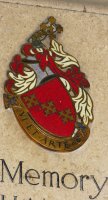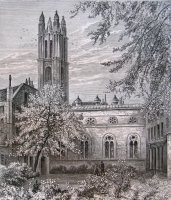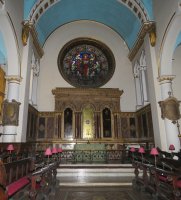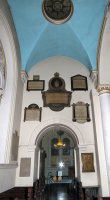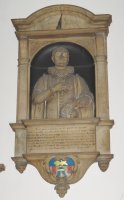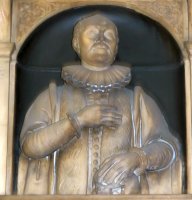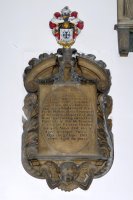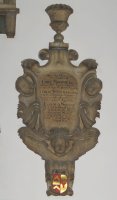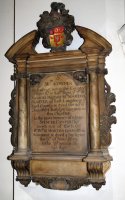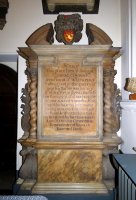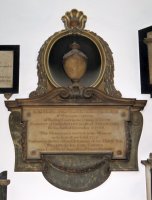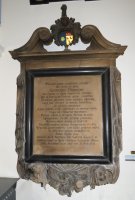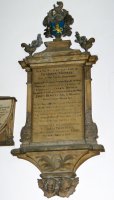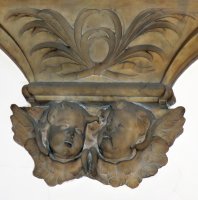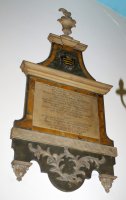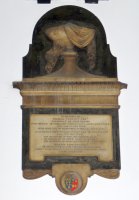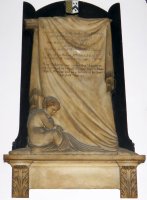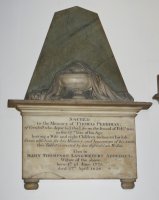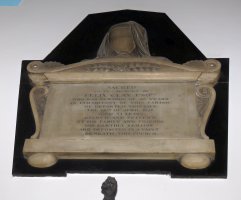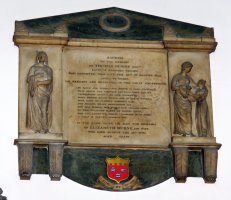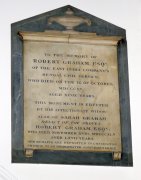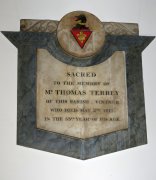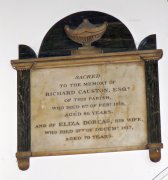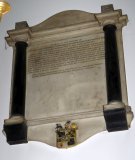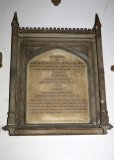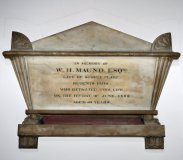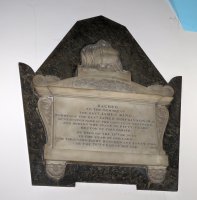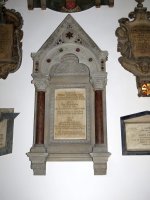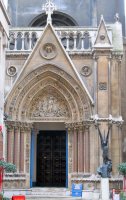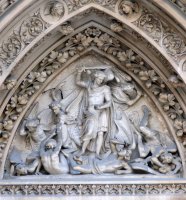St Michael Cornhill Church - Monuments
St Michael Cornhill contains one of the larger collections of panel monuments among the City of London churches, around 40 in all, of which over half are 19th Century, with the rest roughly split between the 17th and 18th century. This page gives full descriptions - if you only have 10 minutes, see this page.
St Michael Cornhill.
The medieval church of St Michael Cornhillcame under the patronage of the Drapers’ Company from 1503 , as remains the case today. The building itself was destroyed in the Fire of London, excepting the tower, and was rebuilt by Christopher Wren, although the architectural historian Pevsner says there is ‘no reason to suppose Wren’s office was responsible for the design’, suggesting this was locally decided and that much medieval work was likely reused. The surviving tower was then found to be structurally weak, and was replaced from 1715-17, first half way up until available funds ran out, and then with new money from the 50 New Churches fund, and the great Hawksmoor as architect, the upper stages were completed by 1721, with pinnacles modelled on the previous, 15th Century spire but more ornate. As the Church is boxed in by other buildings, it is this tower that is the most notable exterior feature, together with the ornate porch onto Cornhill, which was put in when George Gilbert Scott remodelled the interior in 1857-60, whipping out most of Wren’s furnishings. Inside we can see the basilica shape of the interior, with Tuscan columns separating aisles from nave, and high vaulted ceilings. The monuments we are interested in mostly hang in groups in each bay, some rather high up to appreciate.
The collection is fairly large by City Church standards, over 40 monuments in all, though a few are absolutely plain slabs. We have seven from the latter 17th Century, six from the 18th Century, a couple of dozen from the 19th Century including numerous white-on-black panels which were favoured at this time, and a wooden 20th Century piece. The earlier pieces are the more carved, including the John Vernon portrait, several cartouches, a couple of cherubs and various winged cherub heads and skulls, and one piece with small figures. That figure piece is by the sculptor J.G. Bubb, and other sculptors signing works in the Church include one of the Westmacott dynasty and Humphrey Hopper, as well as statuaries Mallcott and Gaffin. A few of the earlier works have been attributed to significant sculptors: Edward Pearce, Jaspar Latham and the elder Cartwright. We take the monuments in roughly date order.
Monuments
John Vernon, d.1615, but the monument being erected by the Merchant Taylors Company after the Great Fire of 1666 to replace the ‘ruined’ original. It is the only piece in the Church with portrait sculpture, a forward facing half-figure portrait of considerable merit. Vernon is shown as of mature years, somewhat balding, with moustache but no beard, with a contemplative expression, enhanced by the posing of his hands, one to his breast as if expressing some emotion, the other resting on a skull, emblem of mortality and death (lots more skulls on this page). He wears a broad ruff - the only jarring part of the composition, for it makes his neck over-long - and a broad, fur lined cloak over a many-buttoned shirt. The statue is within a round-headed niche, with spandrels above carved with leaves, and simple pilasters to the sides supporting curly brackets, again carved with leaves, and a curved pediment above, which has lost whatever it once contained. The inscription is underneath, between two shelves, with a lower apron with cartouche of arms, painted, more leaves and three small termini.
Francis Mosse, d.1657, and his son Henry Mosse, d.1676, when the monument was erected. They were ‘Both sometime ancient Inhabitants of this Parish, Masters of the company of Scriveners & Deputys of this Ward’. The panel has a curved pediment above, with festoons of flowers in front rising to a summit shield of arms, painted. More carved flowers on top of the pediment, and ferny fronds on each side of the inscribed panel, descending to scrolls and a central winged cherub head. Sort of intermediate in evolution from an architectural monument towards the oval shape and structure of a cartouche. Picture below left.
Near-cartouche and cartouche, 17th Century.
John Young, d.1670, a Draper. Modern gilt inscription on an oval panel with a nice border of scrolly Acanthus leaves, this within a rectangular frame carved with freely hanging narrow drapes to the sides, and an upper, swan-necked curly pediment above which has lost its central motif. Below, small cartouche with knotted drapery, and a lower shelf.
Luke Nourse, d.1673, Hugh Wells, d.1673, Citizen & Armourer of London, and Edward Nourse, c.1689, Cit.[izen] & Girdler, son of Luke Nourse and of Mary, daughter of Hugh Wells. This one is an actual cartouche. We have a curved, slightly domed central area with the inscription, a border of scrolls and foliage, quite simplified, and three winged cherub heads: two at the sides, one large-winged one being the base. It is supported on a curly bracket bearing a painted shield of arms, while at the top of the monument is a small urn. Picture above right - click to enlarge.
Sir William Cowper, Baronet, d.1664, and his wife Martha [Master] of East Langdon, and their fourth son, Spencer Cowper, d.1676, who ‘Erected this Monument & Dyed a Bachelor’. First of three monuments to the Cowpers. A grand 17th Century panel, with jawless skulls carved at the top of the inscription to the sides, flanked by polished marble Ionic columns, with leafy scrolls behind those. Above, an entablature and curved pediment, broken at the top to fit the carved coat of arms. At the base, heavy curved brackets, a blank apron, and more leafinesses at the very base. Geoffrey Fisher of the Conway Library suggested this piece as perhaps the work of the sculptor Jaspar Latham.
Cowper monuments (click to enlarge, hover for caption).
Sir Edward Cowper, d.1685, 2nd son of Sir William Cowper, who ‘having left many living monuments of a most just & charitable life orderd this Tombe to be Erected by his Nephew and sole Exec.r Edward Cowper’. A grand mass of marble rising from the floor, a really large monument. The base is a sideboard like altar tomb, with receding sides and great curled leaves. Above, the inscribed panel is bordered by white stone, and outside of this are twisted pillars, with square attached Corinthian pillars behind and outside, on which are curly leafy carvings most of the way up. All this supports a shelf, on which rests the broken pediment enclosing the coat of arms. Pevsner called it ‘large and unimaginative’, but I think we can be kinder than that: while the elements are conventional, it is well made and includes strikingly coloured marble, somewhat browned by time and likely candle tallow. Geoffrey Fisher has suggested the piece is by the sculptor Thomas Cartwright Senior, another of the sculptor-masons working on Wren’s City Churches.
John Huitson, d.1689, with trophy.
John Huitson [Johannes Huitson], d.1689, and his wife Martha Huitson, d.1681, with a Latin inscription. A large panel, with knotted, freely hanging drapes carved to the sides, and a pair of winged cherub heads, partially covered by the drapes, at the base, flanking a trophy, with crossed flags and weapons, armour and cannon. At the top sits a swan-necked pediment, enclosing a shield of arms with crest and mantling. Pevsner notes that Geoffrey Fisher attributed this piece to the sculptor Edward Pearce (mason to Wren who also was responsible for the dragons at the base of the Monument), however I would suggest this would have been a tentative attribution rather than firmer.
Benjamin Howell, d.1715.
Benjamin Howell, d.1715, goldsmith, noting that he was related to a Lord Bishop of Bristol, Thomas Howell, and to the historian James Howell. Erected by his sister Mary Howell. Rather a grand thing: there are receding pillars to the sides, with curls at the base, and an upper shelf with mouldings supporting a carved shield of arms, with two flaming shells to the sides. At the base, another shelf, then an apron bearing two crossed branches carved in low relief, and with a pair of winged cherub heads at the base.
Sir William Cowper, d.1706, but the monument erected in 1759, under the will of his son, William, Earl Cowper, Lord High Chancellor. He was Baronet of Great Britain and Nova Scotia. With a nice receding frame, curved at sides and base, the latter including a hanging drape, and with curly pediment above, on which rests a thin-stemmed egg-shaped pot, within a roundel with surrounding carved wreath, and shell above. An effective composition. Signed faintly, but I could only read the FT at the end, for ‘fecit’ [i.e. who made it], as it was too high up. Picture further up page.
Timothy Helmsley, d.1765, Citizen and Mercer of London, son of Thomas Helmsley, Alderman of Leicester, and his sister Catharine Muskett, d.1756. Tripartite panel in coloured marbles. The central inscribed panel has a red marble surround, and white shelves above and below; the upper one with mouldings, the lower with low relief scrolling. Above, a curved-sided plinth of black and red, bearing a shield of arms, then a narrower shelf, on which is a summit flaming urn. The lower portion of the monument, the apron, is a piece of black marble cut with various curves, and having upon it a nice pair of crossed branches in white stone, and in the same material, we have leafy termini to each side. A good piece, and typical of the lighter style polychrome monuments of the period.
Later 18th C: from colour to monochrome.
- Arnold King, d.1771, Rector. Pillar-mounted piece, with the inscription on an oval, with red marble surround, curved pediment above bearing an elegant beaker, and leafy terminus at the base.
William Tennant, d.1786, his wife Sarah [Chase] Tennant, d.1761, her father William Chase, d.1752 and mother Ann [Wingfield] Chase, d.1780, erected by a son, also William Tennant. The panel has a dark frame, entablature and shelf with repeating pattern above, supporting a draped pot carved alto relievo above, with a shaped black backing. At the base, painted shield of arms in a circlet, with simple lor relief curls and flowers to the sides. A less usual composite piece.
Westmacott's panel to the Platts, 1802.
John Platt, d.1787, and his wife Ann Platt, d.1802, erected by their children. Carved as a hanging drape, rather more ornate than usual for such things. Thus it is hanging over a concealed panel with upper shelf, and has seated at the base a plump putto (see this page for cherub and putti sculpture), who has tucked his feet under the drapery, presumably for warmth given his lack of clothing. Nicely carved leafy brackets below, and small painted shield of arms above, and a backing to the upper portion, cut to curved pediment and ears shape. Signed by Westmacott, which in this case is recorded as Richard Westmacott Senior, first in the dynasty. The signature looks like ‘Westmacott Junr Sculpt’ so I wonder if it is in fact the second, and more famous and prolific one, Sir Richard Westmacott RA.
Peter Michell, d.1790, Secretary to the Hon. East India Company: ‘By his unwearied Diligence, faithful Conduct, and affable Deportment, during Fifty two Years devoted to that Service, he acquired the Esteem, and Respect, of All with whom he was connected.’ An odd little monument. The inscription is on a semicircular panel, curved side down, with receding sidepieces, as if it were a collapsed folding table; at the top, a small painted shield of arms below a carved pot. The piece has inclusions of black and brown marble, and would have been quite colourful when new.
Obelisk monuments: Perriman and Clay.
Thomas Perriman, d.1803, ‘leaving a Wife and eight Children to lament his loss’ – it was she who erected the monument, to which her name is added later as Mary Thompson Langley? Adderley, d.1826: the ‘Langley’ has been overcut with ‘Langweeedt’. Above the inscription, a shelf on which rests a pot, with fine drapery falling around it, and an obelisk as backing, and rounded brackets below. Obelisk monuments form a whole class of church monument, and here is a page about them.
Elizabeth Le-Mesurier, d.1804, wife of the Commissary-General to HM Forces in Egypt and the Mediterranean, noting that ‘Her form was lovely, her manners cheerful, her understanding cultivated’, etc. With black attached pillars to the sides, upper shelf and upper cut as a wavy pediment with a painted shield of arms, and similar wavy apron below.
Joseph Causton Knight, d.1805, tea-tray shaped panel.
Ann Asperne, d.1806, and added later in gilt rather than cut in, husband James Asperne, d.1820. Another hanging drape panel, curved round a pillar. Again of unusual type, with knots at top and sides, and three tiny winged cherub heads above the inscription. Made of artificial Coade Stone.
Thomas Townsend, d.1791, and wife Susanna Townsend, d.1810. Plaque with black backing, small brackets, and on top, a small pot on a meagre bit of stone, with T.S.T upon its side.
J.G. Bubb's monument for Thomas and Eliz. Burne.
Thomas Burne, d.1812, of Bedford Square, and his wife Elizabeth Burne, d.1778. With figure sculpture on broad pilasters to the sides: on our left as we look at the monument, a woman stands in Grecian costume, but with draped head, holding a book, likely emblematic of Faith, and to the right, a group of a woman with her arm around the shoulder of a smaller woman – not a young girl, but a physically smaller woman. They are joined by drapery across their free arms, and the larger is holding some block. An allegorical representation of Charity I would think (see this page for more statues of Charity). For the rest, we have a black upper cut out pediment shape, but acroteria above the two pilasters, both sides facing outwards from the centre of the monument, which feels architecturally blasphemous, and a small snake swallowing its tail, Viking symbology which is also somewhat pagan for the Church, but common enough on monuments (see this page for more about use of snakes in sculpture). At the base, four nice leafy brackets, and central enamelled shield of arms. The piece is signed by the sculptor J.G. Bubb, and the figures are typical of his style. He has a modest number of figure pieces in various churches, made large standing figures for public buildings including one of the Nash terraces by Regent’s Park, and has one very grand City monument in the Guildhall, to Pitt the Younger.
Sarah Majendie, d.1813, wife of a merhant in the East India Company’s Civil Service, Bengal. Plain tomb chest end with a shelf.
Robert Graham, d.1815, of the East India Company’s Bengal Civil Service, and added later, his wife Sarah Graham, d.1845. with an upper shelf and small pot above, and mean brackets below, and on a shaped dark backing.
1810s: variety in white-on-black panels.
Thomas Terrey, d.1817, Vintner. An unusual composition, with thick grey frame, circular, painted arms above, with carved scrolling to the sides.
Richard Causton, d.1818, and wife Eliza Dorcas, d.1817. Tomb chest end, here with the sides as black pilasters, and semicircular backing on top with a small pot, and acroteria to the sides.
George Augustus Nash, d.1825, and his daughter Maria Nash, d.1824, and added later, his wife Lydia Nash, d.1837. With pilasters to the sides, shelf above with a curve-sided lid, looking oddly incomplete, and a wavy base. Nearby is another panel to Andrew John Nash, d.1829. A nicely proportioned tomb chest end, with fluted, receding sidepieces, cut to pediment shape above, and with jelly-mould supports.
John Oakley Maund, d.1826. Tomb chest end with lid, acroteria with anthemion, and little feet. And another panel to W.H. Maund, d.1838, which is a casket tomb (see the page of white-on-black monuments for examples of these different types), with outward leaning sides, pointy lid and acroteria to the sides, lion’s feet below, resting on a shelf with brackets. Well proportioned.
John Fox, d.1828, late of Kingston, Jamaica. Plain tomb chest end on shaped backing.
Felix Clay, d.1828, a neatly carved tomb chest end, resting on little half-spheres, with curls to the sides, curly pediment, and pot on top, with a few leafy carvings - see picture further up page. On a black backing cut to a stumpy obelisk (it looks even shorter in the picture because we are looking upwards). Signed by the notable monumental sculptor Humphrey Hopper. He has various rather similarly composed panels dotted around outer London, as well as figure pieces, and I hold him in great affection for his splendid figure of a mourning girl to J.H. North in Harrow on the Hill Church.
Mary de Teissier, d.1831, son Captain Lewis de Teissier, and daughter Mary [de Teissier] Prevost, placed by another brother, James, Baron de Teissier, plain panel to members of an illustrious Huguenot family.
Lieut. Colonel George Edward Graham Foster Pigott, d.1831, with a note of his military service. The tightly written text leaves plenty of room for his wife and children’s epitaphs below (it was they who erected the monument), but their names were never added. Black-shafted pillars to the sides, and wavy top and base; the latter includes a shield of arms, but whatever was at the top has been lost.
1830s variety: Pigott, Wrench and Maund.
James Stewart, d.1816, Elizabeth Ann Stewart, d.1833, and added later, her husband and his nephew, also James Stewart, d.1863. Panel with upper shelf and cut outs, and little feet. Signed, not that it merits it, by Atkinson & Browne, Goswell Road. John Atkinson and Thomas Browne had their premises at 100 Goswell Street (now Goswell Road), and were the masons of the 1820s Salters Hall (long since gone), and have the odd panel here and there; this one is rather feeble.
William Swansborough, d.1833, a civil engineer, his daughter Emma Swansborough, d.1833 as an infant, sisters Mary, d.1813, and Alice Oake, d.1820, and his wife, Jane Swansborough, d.1838. Rather small, tight writing on a tall panel, with upper and lower shelves, and minor decorative flowers, and brackets, on a shaped black backing.
Thomas Robert Wrench, d.1836, Rector for 42 years, his wife Sarah Wrench, d.1835, and their son Jacob Wrench, d.1837. A Gothic piece, as a blind window, within a rectangle, allowing for spandrels, thin columns to the sides, with pinnacles, and a battlement. Typical of one favoured type of revival Gothic panels. A separate plain panel with frame is to another son, Thomas William Wrench, d.1875, Rector for 39 years, inheriting the post from his father, and his wife Diana Maria Wrench, d.1876. For some reason there is a replicate tablet saying the same things, on speckled stone, with an enamel badge at the top (see picture at top of page, click to enlarge).
Stonemason J Mallcott, panel to The Revd. James King.
The Revd James King, d.1842, formerly the Revd James Simpkinson, of Staunton Park, Hereford, Rector for 50 years. A good tomb chest end, really quite ornate. The curved lid above the inscribed panel has carved upon it in relief crossed olive branches tied with a ribbon; on top is a fine asymmetrically draped pot, and to the corners are spiralling acroteria enclosing flowers; beneath these to the sides are curly designs again with flowers, and at the base, the curved feet contain further relief designs. Ona shaped backing of black marble with pale inclusions. Signed by J. Mallcott, who has a few panels dotted around the City Churches.
Hannah Cooper, d.1830, husband Alexander Cooper, d.1839, and sister Elizabeth Walker, d.1843. Vertical panel, pointed at the top and bearing a lightly carved circle at the top, with a sleeping cherub below the inscription, carved in alto relievo and a bit sweet for modern taste, with a cross and frondy branch behind. A bit of drape goes over the coffin-like baes, on which hare two carved wreaths. Supported on two blocky brackets, one signed by the sculptor, W. Groves. This is William Groves, who studied and exhibited at the Royal Academy, with a small oeuvre of known works, including a few other memorial tablets from around the date of this one.
Thomas Milroy, d.1837, his grand-daughter Mary Anne, d.1837, John Milroy, d.1838, and Alexander Milroy, d.1846. Plain panel cut to pediment above bearing the word ‘Sacred’ with flourishes.
Elizabeth Headington, behind a cabinet and I could not see the date. Tomb chest end with pedimental lid and acroteria.
William Richardson and family.
William Richardson, d.1810, his wife Ann Richardson, d.1827, and their daughter Ann, d.1860, when the monument was clearly made. It is a typical example of a more ornate mid-Victorian design, in the form of a blind window with overhanging canopy resting on free-standing pillars. Rather free in how the different architectural styles are used, for we have Classical forms used in an overall Gothic composition, rather similar to Pearson’s slightly later entrance to the Church. The arches are round-headed, the pillars with leafy capitals on thin shafts, the foliage of Gothic form but carefully symmetrical. In stone rather than white marble, very much the Gothic convention, the round-headed top and circle above in a Gothic idiom, and with various inclusions of coloured stone which could only be Victorian.
James William Vivian, d.1876, Rector for nearly 34 years. Casket end design, with wavy lid and a cross on top, raised on several steps like a churchyard cross. Little feet below, and the whole on a grey backing cut to roughly pentagonal outline with concave upper edges; a pleasingly dumpy silhouette overall. By Gaffin of Regent Street, most prolific of all the white-on-black monument makers.
John Henry Joshua Ellison, d.1944, Rector and with various other titles, a wooden panel in the style of an older stone one, with swan necked pediment enclosing a cross, shelf and apron below. Unusual.
Douglas Thornbury Garrett, Knight, d.1949, solicitor the rectory. Plain speckled panel.
Harold Darke, d.1966, oval with a line of music inscribed.
A modern brass to William Hunt, d.1887, Rector, typical of the genre, with red capitals, an a border with repeating design, here of embossed flowers, with square red coloured studs at corners etc.
John Vernon, d.1615
Also in the Church:
We must start with the Pelican feeding its Young, one of the few things kept by Gilbert Scott from the Wren furnishings, or according to another story, saved from his depredations by the clergyman’s daughter. It is very large, made of painted wood, and rather than a conventional pelican, we see a vicious palaeolithic creature with hooked beak and cruel gaze, surrounded by its brood of four young, avariciously pecking at their mother’s breast for blood. A treasure of the Church, characterful and unforgettable.
The pulpit, from a 1790 repair to the Church, wooden with sounding board.
The font, dated 1672, renovated 1860; Octagonal with gadrooning (corrugation) around the outside of the bowl, resting on an octagonal red-shafted pillar, white marble at the leafy top and stepped base.
Gilbert Scott’s colourful reredos and altar surround, in many-coloured marbles and exceedingly rich in appearance, and including older tall panels of Moses and Aaron.
Angels supporting the ceiling arches, painted and gilt, of wood. By J. Birnie Philip, who made the St Michael statue outside.
Three war memorial panels.
The Pelican feeding its Young
Outside the Church
St Michael Cornhill Victorian porch.
There is a very small churchyard behind, accessed via St Michael's Alley, affording the only exterior view of the walls of the Church. The main thing to see however is the entrance porch, an ornate Victorian structure with concentric arches and a tympnaum above the door filled with a sculptural group of St Michael striking down Satan. This is by the sculptor J. Birnie Philip whom we noted above. There is much vegetative carving on the arches over the tympanun, including little heads, presumably also by Birnie Philip, and more on the pillar capitals and to either side of the door. Above on the gable is a half figure of Christ in a roundel, with adoring angels looking from roundels to the sides (you can see it in the picture above left, click to enlarge).
There is also a more modern statue of St Michael as an angel, rather elongated, besatlike monshter below, and brood of naked figures huddling away: this is a World War I memorial, and is by the 20th Century sculptor Richard Goulden.
Just down the road is St Peter Cornhill, with a more modest collection of monuments, and excellent woodwork.
The Church website is at https://www.st-michaels.org.uk/our-history/.




